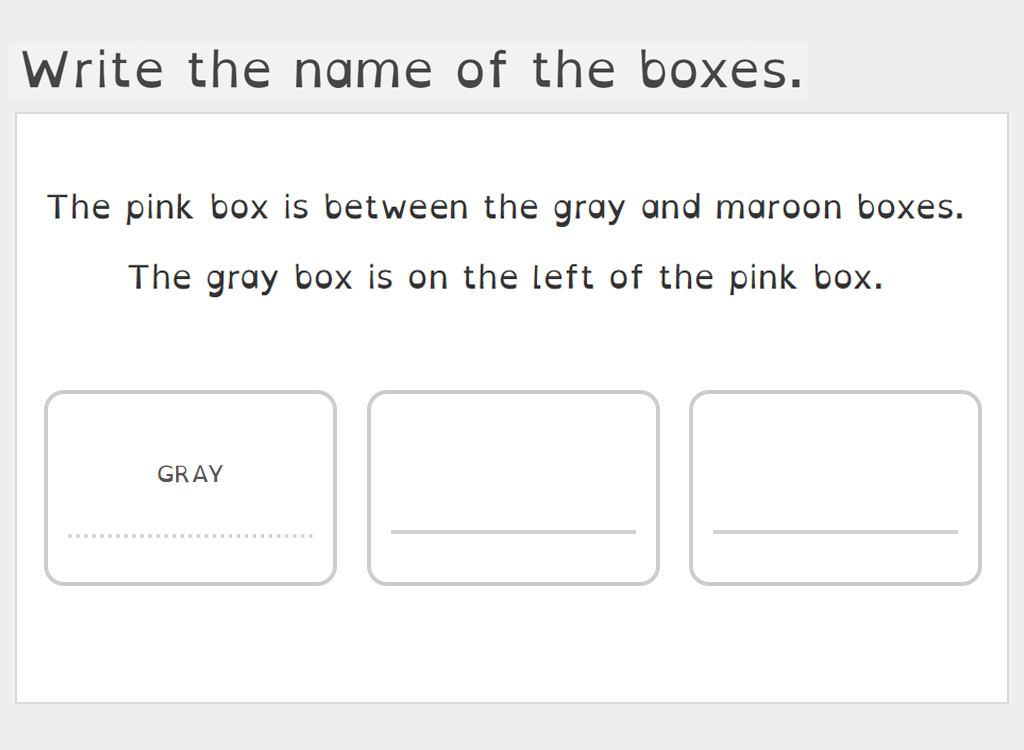Name the Box
Questions in this activity are based on directions- left and right. This activity is meant for those who have difficulty with directions. Students should effortlessly distinguish right from left. A good orientation of direction is required to use language and to learn maths. A child who has left-right confusion may read or write b for d. Similar looking letters may confuse the child. Problems with directions come in the way of doing the four mathematical operations- plus, minus, multiplication and division. One cause of the left-right confusion could be visual processing disorder (VPD). Read more about VPD in the home page of this website.
How is this activity organised?
There are three levels in this activity. Description of the position of various boxes is given. The challenge is to identify the position of the boxes. The number of boxes goes up at each level.Level one has three boxes while level two has four boxes. Level three uses five boxes. The terms used in the questions are: left, right, next to, between, first, last, in the middle, before, after etc. The user should be familiar with these expressions.
This is a higher order thinking activity. Don’t force the child to do the activity. Also, don’t teach the child how to do the activity. If needed, help the child with the language used. Let the child figure out how to do the problem.
There are several steps in problem solving. Some aspects of problem solving are listed below:
- Understand the problem. Have a clear idea of what the problem is about.
- Make use of the information given. Draw conclusions or inferences from the information provided. Relate the information to the problem.
- Find out a strategy to do the problem. Use trial and error method. Ask and find out: Is there a pattern in these problems? Can the problem be solved in a different way?
- Master the problem. Make questions and test others!
Tips for you, the parents
Sit with your child when she/he does the activity. Don’t interfere when your child makes mistakes. The idea is to find out how the child is trying to solve the problem. If the activity is above her/his level go to some other activity. Try to understand why your child couldn’t do the problem. Is the difficulty with the language or with the concept? If it is difficulty with the language explain the meaning of the terms used. If the problem is with the concept don’t try to explain it to the child. This is for the child to figure it out. However, you can bring down the level of the activity by preparing questions which your child can do. If you are unable to prepare questions, stop the activity for the time being. Find puzzles which your child can do. Create in your child an interest in solving puzzles. This is a gradual process.
Your child can attempt this activity after a period of two/three weeks. During every attempt to solve these problems, your child may learn something or other about them. Nothing will happen if your child doesn’t do these problems. Be patient. Allow the child to do the problem when she/he is ready to do it. Give your child the joy of self-discovery!
After your child has learnt to do these problems, make your child do these exercises after a gap of two/three weeks. Sit with your child and observe how your child tackles these problems. Is the child able to process the information quicker than before? Your child has already done these problems. How good is your child’s memory?
Learn more about the approach of your child to problem solving. Learn more about how your child thinks. Understanding the thinking process of your child would help you to find activities that are suitable for your child or, better still, make your own worksheets.
If your child has confusion with left-right directions, see the notes to the activity, Identifying Directions.
- Related activity in this website: Identify the direction
- There are many materials available on the net. You can search for easy puzzles for children, verbal and non-verbal reasoning problems. Choose an activity your child can do easily. Slowly raise the difficulty levels.
- Excellent material and videos can also be had from the internet. Search also for these topics: Letter reversals, spatial problems, developing a sense of directions, vision therapy.
- Developing Ocular Motor and Visual Perceptual Skills: An Activity Workbook by Kenneth A. Lane is an excellent book. It details many remedial measures.
- Buy children's magazines regularly. There are many magazines suitable for children. You may get many ideas to teach your child.

